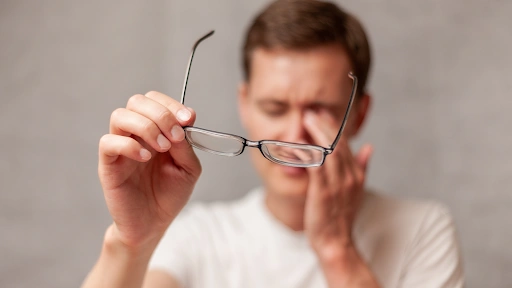If you or your child has ever struggled with blurry vision in the distance, chances are you’re familiar with myopia, also known as nearsightedness. Myopia is becoming more common, especially among children and young adults. Whether you’ve recently been diagnosed or have been managing it for years, understanding how myopia develops, how it progresses, and the latest treatment options can help you manage your vision with confidence. At IndividualEyes, we’re here to walk you through the causes of myopia, the available management strategies, and how modern treatments are offering a better quality of life for those living with this condition.
What Is Myopia?
Myopia, or nearsightedness, is a refractive error where close-up objects are seen clearly, but distant objects appear blurry. This happens because the eye’s shape causes light to focus in front of the retina instead of directly on it. For most people with myopia, this means that reading, using a computer, or looking at your phone is no problem—but anything beyond arm’s length starts to blur.
While myopia can develop at any age, it typically begins in childhood and progresses as the eyes continue to grow. This can lead to an increase in myopia severity over time, and without proper treatment or management, it can worsen significantly.
Causes of Myopia
Myopia doesn’t develop overnight—it’s a gradual process influenced by a combination of genetic and environmental factors. Here are the main contributors:
1. Genetics
Myopia tends to run in families. If one or both parents are nearsighted, their children are at a higher risk of developing the condition. Recent studies suggest that genes related to eye shape and development may play a significant role in myopia.
2. Lifestyle and Environmental Factors
The rise in myopia can also be linked to modern lifestyle habits. Spending long hours focused on near tasks like reading, using devices, and studying without breaks can contribute to eye strain and may cause myopia to develop or progress. The lack of outdoor activities has also been shown to play a role, as time outdoors seems to reduce the risk of developing myopia in children.
How Myopia Progresses
Myopia often begins in childhood, usually between ages 6 and 12, when the eyes are growing rapidly. As the eyes grow longer, the light entering the eye focuses in front of the retina, causing blurry distance vision. Myopia progression is typically steady during childhood and adolescence, but can slow down in adulthood as eye growth stabilizes.However, progressive myopia can continue into adulthood, especially in cases where environmental factors (like excessive screen time) are involved. As myopia worsens, the risk of other eye health issues, such as retinal detachment, macular degeneration or glaucomaincreases. That’s why it’s essential to stay on top of your eye exams and treatment.
Myopia Management Strategies
Thankfully, myopia management has come a long way in recent years. The goal is not only to correct the vision but also to slow down or stop the progression of myopia. Here are some of the most effective strategies:
1. Eyeglasses and Contact Lenses
The most common solution for myopia correction is wearing eyeglasses or contact lenses. These provide a simple fix for clear vision, but they don’t prevent the condition from worsening. New advancements, however, are offering better solutions.
2. Myopia Control Lenses
Lenses specifically designed to control myopia progression, such as myopia control contact lenses and dual-focus glasses, can help slow down the elongation of the eye. These lenses are designed to focus light in ways that reduce strain on the eye and slow the progression of myopia.
3. Atropine Eye Drops
Low-dose atropine eye drops have been found to slow myopia progression in children. These drops are typically used nightly and work by affecting the eye’s focusing mechanisms, which can help reduce eye growth.
4. Surgical Options
While surgery isn’t typically recommended for children, laser eye surgery (like LASIK or SMILE) can be a long-term solution for adults with myopia. These procedures reshape the cornea to correct the refractive error and offer freedom from glasses and contact lenses.
5. Orthokeratology (Ortho-K)
Orthokeratology, or Ortho-K, is a non-surgical treatment that uses specially designed contact lenses to reshape the cornea overnight. This process temporarily corrects myopia, providing clear vision during the day without the need for glasses or contacts. Ortho-K is especially effective in children and adolescents, helping to slow down the progression of myopia.
Orthokeratology Lenses: A Non-Surgical Solution to Manage Myopia
Orthokeratology (Ortho-K) is a groundbreaking, non-surgical treatment for myopia that uses specially designed contact lenses to reshape the cornea while you sleep. Unlike traditional contact lenses that are worn throughout the day, Ortho-K lenses are worn overnight and gently mould the cornea to correct refractive errors, providing clear vision during the day without the need for glasses or contact lenses.
How Ortho-K Works
The process involves wearing a custom-designed set of rigid gas permeable (RGP) lenses overnight. These lenses gently flatten the cornea, improving how light is focused onto the retina and temporarily correcting nearsightedness. The best part? Once removed in the morning, the reshaped cornea allows for clear vision throughout the day—without the need for any corrective eyewear.
Benefits of Orthokeratology
- Non-surgical: No need for laser surgery like LASIK, making it a great option for those not yet eligible or those looking for a reversible procedure.
- Convenience: No glasses or contacts required during the day. Simply wear the lenses while you sleep, and wake up with clear vision.
- Slows Myopia Progression: Ortho-K lenses have been shown to slow down the progression of myopia in children and young adults, which is crucial for managing long-term eye health.
- Safe & Effective: The lenses are Health Canada-approved and have been widely used with minimal risk, as long as they are properly fitted and used as prescribed.
Ideal Candidates for Ortho-K
- Children and Teens: Ortho-K is particularly beneficial for children and teenagers, as it helps slow the progression of myopia during their growing years. It’s a great option for parents looking to protect their child’s long-term eye health.
- Adults: Adults with mild to moderate myopia can also benefit from Ortho-K, especially those who don’t want the hassle of daily glasses or contacts.
- Athletes or Active Individuals: Since Ortho-K lenses are worn overnight, they’re perfect for those who lead an active lifestyle or participate in sports and don’t want to worry about glasses or contacts.
Ortho-K at IndividualEyes in Richmond Hill
If you’re in the Richmond Hill area, IndividualEyes offers expert orthokeratology services. Their team of professionals will carefully assess your eye shape, prescription, and overall eye health to customize your Ortho-K lenses. With the right fit, you’ll enjoy the convenience of clear, glasses-free vision throughout the day.
What to Expect
Once you start wearing Ortho-K lenses, you’ll begin to notice improvements in your vision within a few days. Full results can typically be seen after a few weeks of nightly wear, and the effects last throughout the day without the need for glasses or contacts.
However, regular follow-up appointments are crucial to ensure the lenses continue to fit properly and your vision stays sharp. As with any treatment, there are some risks associated with improper lens care, such as eye infections or dryness, so it’s important to follow the prescribed cleaning and wearing schedule.
Preventing Myopia
While you can’t always prevent myopia, there are steps you can take to reduce the risk of developing or worsening the condition:
Encourage Outdoor Play: Studies show that children who spend more time outdoors are less likely to develop myopia.
Take Regular Breaks from Close Work: Follow the 20-20-20 rule—every 20 minutes, take a 20-second break and look at something 20 feet away.
Limit Screen Time: Excessive time spent on digital devices increases the risk of myopia. Try to balance screen time with outdoor activities.
Get Regular Eye Exams: Regular check-ups with your optometrist can help catch early signs of myopia and manage it effectively.
Myopia in Children: What Parents Need to Know
For parents, managing their child’s myopia can feel overwhelming, especially if the condition progresses quickly. The earlier myopia is caught, the better the management options. Signs that your child may need an eye exam include:
- Squinting or rubbing their eyes frequently.
- Complaints of blurry distance vision, especially when watching TV or reading the board at school.
- Difficulty seeing objects in the distance.
Regular eye exams are key to keeping myopia in check, and many myopia control options, like specialized lenses, are available to slow progression.
Myopia in Adults: Understanding the Risks
As myopia progresses into adulthood, it’s crucial to monitor eye health carefully. Adults with high levels of myopia are at a higher risk for complications like:
- Retinal Detachment: A rare but serious condition where the retina pulls away from the back of the eye.
- Glaucoma: High levels of myopia can increase the risk of developing glaucoma, which can lead to vision loss if left untreated.
- Macular Degeneration: Adults with high myopia are at greater risk for macular degeneration, particularly myopic maculopathy, a type of age-related macular degeneration (AMD) associated with severe nearsightedness.
If you’re experiencing significant changes in vision, it’s important to talk to your optometrist about your options for myopia control or corrective surgery.
Protecting Your Vision with Myopia Management
Living with myopia doesn’t mean you have to let your vision deteriorate over time. With the right treatment and management strategies, you can maintain good vision and prevent further progression. Whether it’s through glasses, contact lenses, Ortho-K, or modern treatments like atropine eye drops, there are options to slow myopia’s effects. At Individual Eyes, we’re committed to helping you manage myopia and keep your vision clear.Ready to take control of your vision?Schedule an appointment with us today to discuss myopia management strategies and find the best treatment for you or your child.



